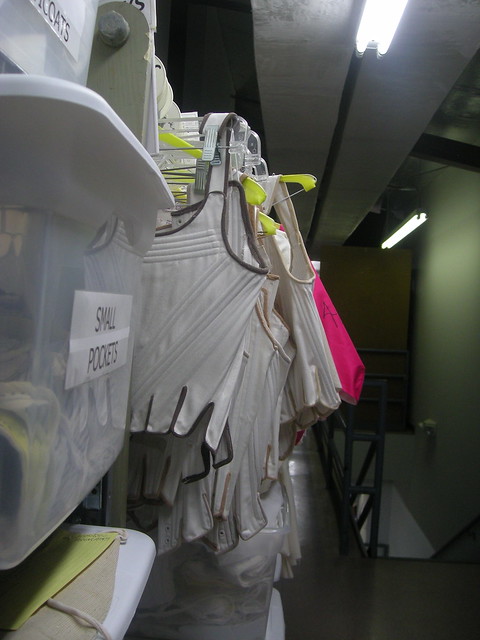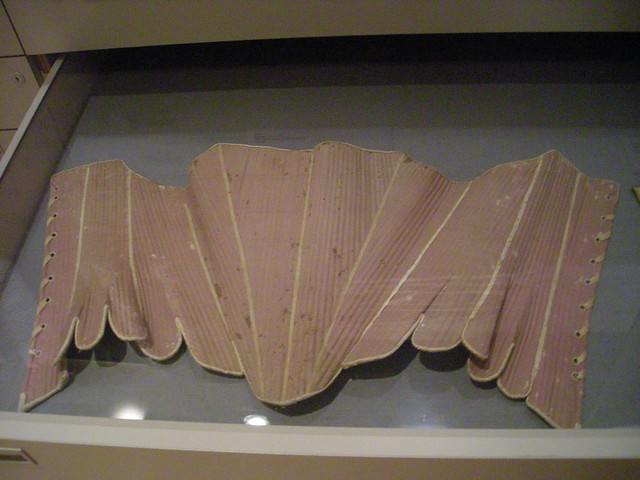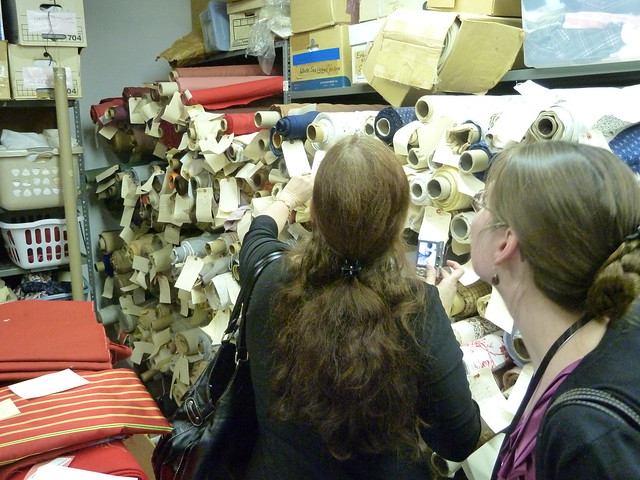Day two began with Session III: Technicalities, starting with Jenny Tiramani (costume and set designer and dress historian, London, England) presenting on “Fitting New Bodies in Old Shapes: Experiments with Patterns of the Past.” Most of the information and photos that Jenny shared with us are unpublished (but soon to be!) so I cannot share all of the details here, but you can pre-order her new book, Seventeenth-Century Women's Dress Patterns: Book 1 on amazon.com. She is currently working on subsequent volumes, and on finishing the work of her late friend and fellow costume historian Janet Arnold, so stay tuned for more goodies in the future!
Extant stays, 1740-1760, in the CW collection (featured in Costume Close-up)

Next on the program was Dr. Lynn Sorge-English (Department of Theatre, Costume Studies, Dalhousie University, Halifax, Nova Scotia) with her presentation “Stays for the People.” Dr. Sorge-English also presented some unpublished work, which I consequently (and unfortunately, sorry!) cannot share here, but she too has a soon-to-be-published book from which her talk was drawn: Stays and Body Image in London: The Staymaking Trade, 1680-1810 can be pre-ordered from amazon.com. In brief, her talk explored the life of one rural English staymaker in the mid-18th century. Using his diaries, heretofore only read in light of their religious association, she gleans a fascinating spectrum of information about the staymaking trade, its practitioners, and even its customers. Be sure to check out her book to read more of this exciting scholarship. Accompanying her discussion on stays, she also described her work with the CW Costume Design Center to help establish stays patterns that could easily fit any interpreter. The stays, which come in 10 set sizes, can accommodate staff of any shape and size, eliminating the extensive (and expensive) task of fitting a new pair of stays for each staff member. Yet another example of a necessary but working compromise of costuming historic sites.

The "stays for the people" developed by Sorge-English,
still used by the CW CDC to fit costumed employees.
Saundra Ros Altman (creator and owner, Past Patterns, Dayton, Ohio) and Isabelle M. Lott (CEO, Pattern Works International, Grand Rapids, Michigan) discussed their experiences in pattern-making from extant garments. Saundra started her company with next to nothing and has been able to build it into a wonderful resource for costumers. Isabelle demonstrated her use of CAD (a computer software) to draft patterns efficiently, which offers some great potential to historic sites needing to quickly and easily scale up or down available period patterns.
Following a coffee break (I know it seems like we had a lot of coffee breaks, but with so much information coming at us, we needed the extra boost!), we had a presentation by fellow blogger Abigail Cox (of Stay-ing Alive), who spoke on “Educating and Constructing over the Internet: The Popularity, Potential, and Perks of Historical Costuming Blogs.” She outlined this new “genre” of blog and explored the potential for a wider use of blogs by museums to highlight and make more accessible their costume collections. A question from the audience encouraged some further discussion on this topic. Costume scholars and enthusiasts are clearly reaching out for more knowledge, and further details from the museums would be helpful and widely appreciated, and an asset for museums because of the audiences they could draw. The difficulty with this is, of course, that museums struggle with the wider dissemination of their collections because of possible implications on their visitation; would you visit a museum if you could access everything online?
“New Opportunities: Developing and Teaching Classes on Historical Clothing Construction” by Carolann Schmitt (Genteel Arts, Gettysburg, Pennsylvania) discussed techniques for developing costume workshops for re-enactors and the staff of living history sites. She shared her own experiences in creating classes and figuring out the most effective ways to organize and teach period construction techniques. She provided a wonderfully helpful set of guidelines to think about when planning such classes, and stressed that it is often the opportunity to have a garment custom-fitted that helps draw individuals. Johanna Tower (historical clothing and textiles, Plimoth Plantation) followed with a discussion of the link between historical knowledge and applied skill.
CW apprentice tailor Neal Hurst at work in the Margaret Hunter Shop, July 2010.
Concluding the morning session was Neal Hurst (apprentice tailor, Historic Trades, Colonial Williamsburg), who spoke on “The Bridge between Craftsmen and Academia: The Tale of Two 21st Century Apprentices.” He began by outlining the trades programs at CW, most specifically those practiced at the Margaret Hunter shop. The shop opened in 1954 simply as another souvenir store; slowly, CW began using the trades as education and preservation tools, thus greatly enhancing the mission of the foundation. Beginning in the years after World War II, CWF initiated a number of apprenticeship programs, though it wasn't until 1995 that an apprenticeship for the millinery and mantua maker trades were established, and not until 2003 for the tailor. While CW cannot hold their employees to the strict rules of a true 18th century apprenticeship, they still follow the basic structure of this learning curriculum. Apprenticeships last seven years, and after completion of certain goals and projects, they are promoted to journeyman/woman. Neal highlighted the importance of these trades, stressing that some of the tradesmen at CW are the only practitioners in their field left in the world, and thus how essential it is that their knowledge be carried forward through educational and training programs like those offered at CW. (If you're interested, one of Neal’s apprenticeship projects even has a facebook page.)
Interns are also an important addition to the trades of CW.
We were surprised at lunch time by our friends Laurie and her daughter and son, who came into town for the weekend! We had a nice relaxing lunch together at the DeWitt Wallace café (still no Brunswick stew) and then took a walk through the Accessories from Head to Toe exhibit upstairs. (Just so you all know (because it is that important to me!), I did finally get my Brunswick stew at Huzzah! that evening!)
Following lunch was a presentation by Frances M. Burroughs (director of operations, Educational Programs, Productions, Publications and Learning Ventures, CW) titled “Extending the Message: Historical Csotume Exhibitions and Media.” She shared with us some of the innovative ways that CW is using to extend its exhibits to a wider audience, such as the use of the current Historic Threads online exhibit, photos and slideshows, podcasts, and even a video which plays in the exhibit space (we all got to view the video on the “big screen” accompanied by some fun production stories and anecdotes about the filming process!). Clips from the video can be seen in this recent vodcast about the exhibit.
“Stepping into Their Shoes: Visitor Engagement at Historic Sites through Costuming” by Elizabeth L. Mauer (creative director, Re-Living History, Alexandria, VA) took a look at how visitors wearing costumes affects their interactions and experiences with costumed interpreters. She used a story of a young visitor to CW who, while dressed in costume, received special attention from interpreters; they acted as if she was “one of them” or “in the know," encouraging her to adopt her own period persona in a way, immersing her fully in the educational interpretive scenarios. Dressing up as a type of “play” thus becomes an invaluable method for learning through suggestive interaction, rather than passive didacticism. Elizabeth said that this paper will be on her website soon, so be sure to check there to read more.
The next presentation by A. Newbold Richardson (Past Crafts Textiles and The Costume and Textile Specialists, Alexandria, VA) entitled “More Than Play: Serious Interactive Dress-ups for Museum Educators” flowed nicely from the previous talk to further explore the use of costumes to transport children in order to help them grasp a better understanding of the time period portrayed. Since so many museums have limited budgets (especially when it comes to costumes), and since most children do not really know how accurate a piece of clothing is, she suggests using the costumes as more of a tool to understand period posture and deportment - to help feel what it felt like "back then" - rather than as strictly historically accurate objects of study. For example, a tight fitting waistcoat (even if it is the only piece of clothing for a child to wear) will give them an idea of the posture and restrictions of the time period much better than simply seeing the garment worn by an interpreter. Shy children or those with disabilities can be easily incorporated into the lesson through the simple act of being costumed alongside their peers, providing a shared experience through what she termed "socio-dramatic play."
Tailors' workspace at the Margaret Hunter shop.
Following our last coffee break was a panel discussion titled “How Accurate is Accurate Enough?” The panel consisted of Tom Hammond (CW, CDC), Jenny Tiramani (costume designer and dress historian), Hannah Howard (Pennsbury Manor State Historic Site, PA), Natalie Garbett (costumer), and Mark Hutter (CW journeyman tailor). I was very excited for this discussion, but as the first questions were put the panel, I could tell that this was going to be a very general discussion. I felt that the panel, as well as the participants from the audience, was being too careful and polite about certain issues. Based on the presentations and discussions so far, it is evident that everyone and every site has their own opinion and standards when it comes to the use of costumes. However, it was also evident that many have a very strong opinion on one practice or another, and I think it would have been enlightening to delve into further discussion and debate concerning some of these practices and issues. I think this may have also provided those who are new to costuming or who are struggling with issues at their site to examine more closely the possibilities that are out there and to consider what might work best for their own individual site.
Following the panel, Dr. Jane Malcoln-Davies returned to discuss “Measured Smiles: Benchmarking Front-of House Staff’s Contributions to Visitor Experiences.” Once again, her research and discussions with various historic sites allowed her to share statistics on interpreter training, effectiveness, and visitor reactions to costumed interpreters.
Our keynote speaker, Richard Pickering, ended the session with another rousing talk. He described how we are “standing on jello”: what we think is right today, will inevitably change tomorrow. Our vision of history is constantly shifting and it is important that we help the public to understand this, while keeping aware of it ourselves as we continue to learn and grow and educate.
I want to say congratulations and thank you to Colonial Williamsburg, the staff who organized this conference, the wonderful presenters, and all of the registrants who attended. This was such a unique opportunity for us all to explore the many uses and advantages of costumes and how they can impact our educational efforts. These two days were packed full of new ideas and important discussions which I hope will continue throughout the museum and costuming communities.
The conference ended with an open house and reception at the CW Costume Design Center. The staff kindly placed projects around the building for us to admire and examine, and very graciously answered all of our inquiries and curiosities while we enjoyed some tasty treats.
Costumes on display at the CW Costume Design Center.
K.C. and Rebecca drooled over the bolts of fabrics...
...While I drooled over this reproduction of Jefferson's 1790 great coat!








9 comments:
Thank you so very kindly for your detailed coverage of the symposium. Almost feel as if I had attended :}
Very best,
Natalie
You are most welcome! We had a great time and walked away with so many new ideas. I'm glad we could share it with you all!
My goodness, you packed a lot in.
Thank you so much for sharing this play-by-play! I couldn't make it out, but man I wish I'd been there to hear these lectures. I'm fascinated by how CW and other sites clothe all their re-enactors, and it was particularly interesting what you noted about the standardized stays pattern. Thank you!
It was definitely a busy few days!
Lauren - We talked a lot about how different museums build their costume collections. All museums have different needs in terms of what their interpreters do and the types of programs/trades they portray. And all museums have restrictions as well (budgets, staff to make the costumes, etc.). So it was really interesting to hear how different organizations overcome these obstacles to fulfill their missions.
Wow, there's a lot of stuff in this one! I didn't know about the tailor's facebook page about the coat he is doing. I'll be following that! I liked how children and special needs children were incorporated into some of the ideas.
Laurie
Laurie, the discussions about the highly positive effects of children's education through costuming were definitely some of the finest of the conference. There is so much work left to done on teaching history through immersion and "play." All I could think of while these speakers talked were you own successful adaptations of these ideas. You're case-in-point evidence for these studies and how well costuming can be made to function as a teaching tool.
What a great post! I follow several blogs that have mentioned the symposium, but this is by far the most informative. Thank you, heartily, from someone on 'the outside looking in!'
Thank you for writing up the 2nd half of the conference. I was only at the Mon/Tues portion, and attended a workshop on Wed, so it's nice to read about the rest of it.
Val
Post a Comment